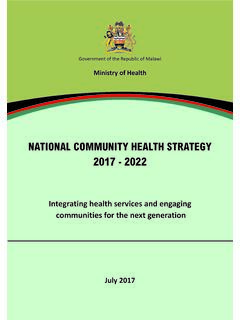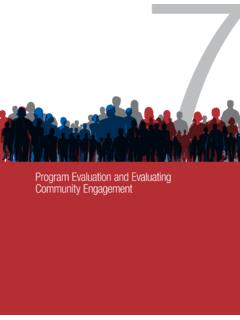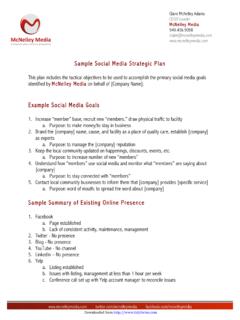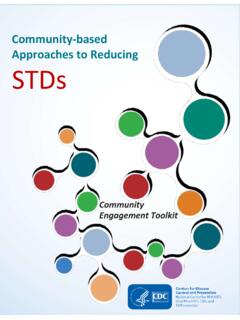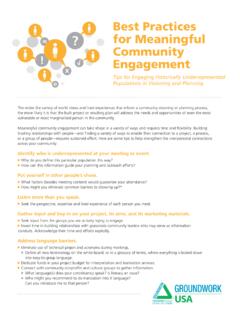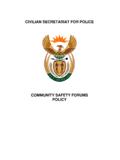Transcription of WHO | Module B5
1 community engagement Module B5. 1|. Module objective By the end of this Module , you will be able to: Describe why community engagement is essential for effective emergency risk communication Describe the links between health promotion, social mobilization and community engagement , and List actions for community engagement Photo: 2|. Communities MUST BE at the heart of any public health intervention, especially in emergencies community engagement is central to any public health intervention. Its importance is even more significant during public health emergencies. community engagement involves those affected in understanding the risks they face, and involves them in response actions that are acceptable.
2 Photo : WHO /A Bhatiasevi 3|. Approaches and tactics linked to community engagement Social Mobilization community engagement Communication for Outbreak Development (C4D) communication Behaviour Change Crisis communication Communication Risk Communication Health Education Communication for Health Promotion Behavioural Impact Photo: 4|. Health promotion health education A set of principles involving equity and empowerment, and practices encompassing of communication, capacity building and politically oriented activities, with the goal to enable others to gain more control over the influence of their lives and to improve their health.
3 Health Education aims to provide information to influence their future decision-making on their health. Health Promotion aims at working on the needed social and political actions ( legislation, movements, etc.). - (Laverack, 2014). Photo : WHO /A Bhatiasevi 5|. Social mobilization Social mobilization is a process that engages and motivates a wide range of partners and allies at national and local levels to raise awareness of and demand for a particular development objective through dialogue Photo: Members of institutions, community networks, civic and religious groups and others work in a coordinated way to reach specific groups of people for dialogue with planned messages.
4 Social mobilization seeks to facilitate change through a range of players engaged in interrelated and complementary. - UNICEF. 6|. community engagement community engagement is the process by which community benefit organizations and individuals build a long term relationship with collective vision for the benefit of the community It is primarily about the practice of moving communities towards a better change through empowerment This presentation will focus on community engagement for risk communication Photo : WHO 7|. What we usually do for health promotion, social mobilization include . Messages Leaflets Posters T-shirts Radio spots TV adverts Town criers Photo : WHO BUT community engagement requires much more than these 8|.
5 Why community engagement ? Everyone has a right to know about risks to their health and well-being Culturally appropriate information can help make informed decisions to reduce the health risks Action taken by individuals, families and communities affected are key to controlling the public health Graphic: threat/problem engagement /what-is- community - engagement 9|. Actions for community engagement community engagement covers a broad range of activities. Some activities undertaken by government practitioners include: Reaching out to / informing the community of policy directions of the government Consulting the community as part of a process to develop government policy, or build community awareness and understanding Involving the community through a range of mechanisms to ensure that issues and concerns are understood and considered as part of the decision-making process Collaborating with the community by developing partnerships to formulate options and provide recommendations.
6 Shared leadership / empowering the community to make decisions and to implement and manage change. Source: Victoria Government, Australia 10 |. community engagement Modified from US Department of Health and Human Services and Victoria Government, Australia INFORM CONSULT INVOLVE COLLABORATE SHARED. LEADERSHIP. Some community More community Better community community Strong relationship Involvement involvement involvement involvement Provides Gets information or Involves more Forms partnerships Strong partnership community with feedback from the participation with with community on structure is formed information community community on each aspect of the issues project from development to solution Optimally Develops Visibility of Partnership Broader health established connections partnership building, trust outcomes affecting communication established with building broader channels and increased community .
7 Strong channels for cooperation bidirectional trust outreach built 11 |. Principles of community engagement Planning phase Clarify purpose/goal Understand the community 's culture, perception, economic condition, social networks, political and power structures, norms, values, demographic trends, history, past experience Establish relationships, build trust, work with formal and informal leaders, seek their commitment for mobilizing the community Map and leverage existing community engagement mechanisms, for polio, immunization campaigns, HIV work, red cross volunteers, etc. Photo: 12 |. Principles of community engagement Implementation phase Partner with community to create change and improve health.
8 Recognize and respect diversity; and ensure that the most vulnerable are reached and engaged. Identify, mobilize assets and strengths in developing the community 's capacity and resources to make decisions and take action. Be prepared to release control of actions and Photo: interventions to the community . Be flexible to meet the changing needs. 13 |. Challenges Maintaining community involvement over time Overcoming differences between responders, community and different influencers Working with unique, especially vulnerable, or hard to reach communities Communities and responders may not Image: http://blogs- perceive risk in the same ways community engagement is Communities have complex social dynamics complex, hard work requiring and changing power relationships which expertise and dedicated influence how we engage them resources 14 |.
9 Know the community community structure Formal and informal Opinion leaders and influencers community dynamics Power relationships Sources of information Beliefs and practices Available resources Others Photo: WHO/A Bhatiasevi 15 |. The perception trap - 2014 Ebola in West Africa Trap 1- Fear: Ebola = death Trap 2- Disbelief due to Everybody who has Ebola will die distrust Ebola is a curse The authorities can't handle the situation Trap 3- Dismissal The foreigners are here to extract organs for scientific experiments Don't want to know Don't want to believe Don't want to accept Photo : WHO 16 |. community engagement came late in Ebola outbreak in Liberia Retrospective analysis of the Ebola response Response Phase 1 Phase 2 Phase 3.
10 Predominant risk Crisis communications Awareness-raising, social community engagement communication mobilization strategy Rationale Past experiences of Ebola Ebola spread in major cities. community as part of the solution. outbreaks with 90% deaths, Increased survival rates, but unsafe Bring back trust occurs in remote settings burials and other dangerous practices continue Key message Ebola kills. There is no cure. Bush Ebola is real. Signs & symptoms. Avoid contact with dead bodies. Early meat consumption spreads the Hotline treatment increases survival rates. De- disease stigmatize survivors Intervention Mass media, posters, radio Campaign mode.










